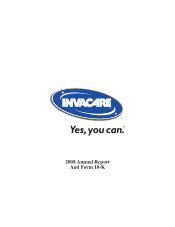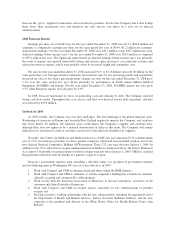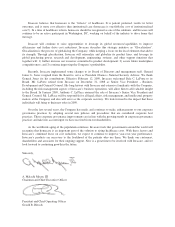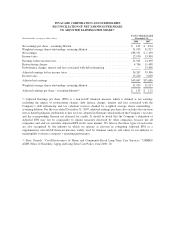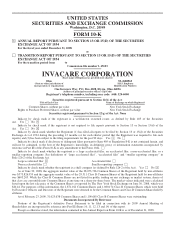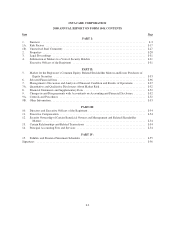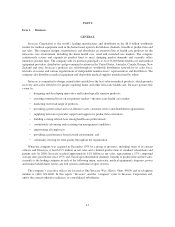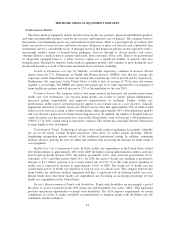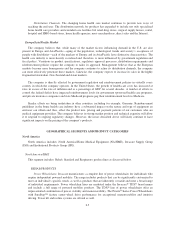Invacare 2008 Annual Report Download - page 10
Download and view the complete annual report
Please find page 10 of the 2008 Invacare annual report below. You can navigate through the pages in the report by either clicking on the pages listed below, or by using the keyword search tool below to find specific information within the annual report.THE HOME MEDICAL EQUIPMENT INDUSTRY
North America Market
The home medical equipment market includes home health care products, physical rehabilitation products
and other non-disposable products used for the recovery and long-term care of patients. The company believes
that patients overwhelmingly prefer care and treatment in their home. There is a growing body of evidence that
home care results in faster recovery and better outcomes. Homecare is more cost-effective and comfortable than
institutional care by a considerable factor. A principal reason is that homecare patients are not exposed to today’s
increasingly virulent strains of hospital-borne pathogens. Invacare through its diverse product and service
offerings delivers a medical trifecta: patient satisfaction; better outcomes; lower costs. There is no question that
an adequately equipped home is a better recovery option for a significant number of patients who face
hospitalization. Demand for domestic home medical equipment products will continue to grow during the next
decade and beyond as a result of the factors mentioned above and more, including:
Growth in Population over Age 65. Globally, overall life expectancy continues to increase. Recent
reports from the U.S. Department of Health and Human Services (DHHS) state that the average life
expectancy in the United States for men and women who reach the age of 65 is now 82 and 85, respectively.
Furthermore, life expectancy in the United States at birth is now an average of 78 for men and women
together, a record high. The DHHS also reports that people age 65 or older represent the vast majority of
home health care patients and will increase to 12% of the population by the year 2050.
Treatment Trends. The company believes that many medical professionals and patients prefer home
health care over institutional care because home health care results in greater patient independence,
increased patient responsibility and improved responsiveness to treatment. Further, health care
professionals, public payors and private payors appear to favor home care as a cost effective, clinically
appropriate alternative to facility-based care. Recent surveys show that approximately 70% of adults would
rather recover from an accident or illness in their home, while approximately 90% of the population aged 65
and over showed a preference for home-based, long-term care. In addition, the number of hospital beds per
capita has fallen over the past twenty-five years in the United States, from 4.4 beds per 1,000 population in
1980 to 2.7 in 2005, a trend which is expected to continue. This decline has coincided with the reduction in
average length of stays in hospitals.
Technological Trends. Technological advances have made medical equipment increasingly adaptable
for use in the home. Current hospital procedures often allow for earlier patient discharge, thereby
lengthening recuperation periods outside of the traditional institutional setting. In addition, continuing
medical advances prolong the lives of adults and children, thus increasing the demand for home medical
care equipment.
Health Care Cost Containment Trends. In 2005, health care expenditures in the United States totaled
$2.0 trillion dollars or approximately 16% of the GDP, the highest among industrialized countries, and were
paid by private health insurers (36%), the federal government (34%), state and local governments (11%),
consumers (15%) and other private funds (4%). In 2014, the nation’s health care spending is projected to
increase to $4.1 trillion, growing at an average annual rate of 6.9%. Over this same period, spending on
health care is expected to increase to approximately 19.6% of GDP. The rising cost of health care has
caused many payors of health care expenses to look for ways to contain costs. The company believes that
home health care and home medical equipment will play a significant role in reducing health care costs.
Recent trends show that home health care expenditures are becoming an increasing percentage of total
health care expenditures in the United States.
Society’s Mainstreaming of People with Disabilities. People with disabilities are increasingly a part of
the fabric of society, in part due to the 1991 Americans with Disabilities Act, or the “ADA.” This legislation
provides mainstream opportunities to people with disabilities. The ADA imposes requirements on certain
components of society to make reasonable accommodations to integrate people with disabilities into the
community and the workplace.
I-4

